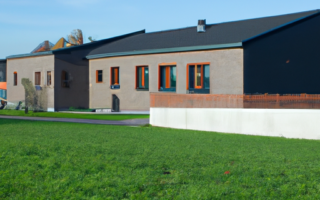Emerging Technologies in Commercial Roofing
Commercial roofing is an essential aspect of any building, ensuring protection and longevity. As technology continues to advance, emerging technologies are disrupting the commercial roofing industry, making it more efficient, sustainable, and cost-effective. In this article, we will explore the latest trends in commercial roofing and how these new technologies are shaping the industry.
One of the significant trends in commercial roofing is the adoption of sustainable and eco-friendly materials. With growing concerns about the environment, building owners and contractors are increasingly opting for roofing materials that have a lower carbon footprint. Green roofing solutions such as vegetative roofs and solar roofs are gaining popularity, as they provide energy efficiency, reduce stormwater runoff, and improve air quality. These sustainable roofing options not only benefit the environment but also offer long-term cost savings, making them an attractive choice for commercial building owners.
In addition to sustainable materials, the use of advanced coatings and membranes is another emerging trend in commercial roofing. These coatings and membranes offer improved durability, weather resistance, and energy efficiency. Cool roofs, for example, use reflective coatings that reduce heat absorption, keeping buildings cooler and reducing the need for air conditioning. This technology not only saves energy and lowers utility costs but also extends the lifespan of the roofing system.
Digital tools and software have also transformed the commercial roofing industry, streamlining processes and improving project management. Roofing contractors now utilize aerial imaging, drones, and 3D modeling software to assess roof conditions, identify potential issues, and develop accurate and efficient roofing plans. These tools help contractors save time and money, as well as enhance safety by minimizing the need for manual inspections.
Another noteworthy trend in commercial roofing is the integration of smart technology. Internet of Things (IoT) sensors and data analytics are being used to monitor roof conditions, detect leaks, and predict maintenance needs. This technology enables proactive roof maintenance, preventing significant damages and minimizing repair costs. Real-time data tracking and analysis allow building owners to make informed decisions, optimize roof lifespan, and reduce overall maintenance expenses.
In conclusion, the commercial roofing industry is experiencing a significant shift due to emerging technologies. Sustainable materials, advanced coatings, digital tools, and smart technology are revolutionizing the sector and providing architects, contractors, and building owners with innovative solutions for their roofing needs. As this industry continues to evolve, it is crucial for professionals to stay updated with the latest trends and embrace these technological advancements for enhanced efficiency and sustainability.
Sustainable Solutions for Commercial Roofing
When it comes to commercial roofing, staying up to date with the latest trends and advancements in the industry is crucial. As sustainability continues to be a global focus, commercial roofing solutions are not exempt from the need to become more environmentally friendly. In this article, we will explore the new trends in commercial roofing that offer sustainable solutions.
One of the key trends in the commercial roofing industry is the use of green roofs or rooftop gardens. Green roofs are not only visually appealing, but they also offer numerous benefits. They absorb rainwater, reduce stormwater runoff, improve air quality, and provide insulation, reducing energy consumption. Green roofs also create additional green space in urban areas, helping to combat the urban heat island effect.
Another sustainable solution gaining popularity is the use of cool roofs. Cool roofs are designed to reflect more sunlight and absorb less heat than traditional roofing materials. This helps to reduce the heat island effect and lower energy consumption for cooling buildings. Cool roofs can be achieved through the use of reflective coatings or materials such as tiles or metal.
The development of solar roofing technology has also made great strides in recent years. Solar panels can be integrated into commercial roofing systems, allowing businesses to generate their own clean energy. Solar roofing not only reduces reliance on traditional energy sources but also provides cost savings in the long run. It is becoming increasingly common to see commercial buildings with solar panels installed on their roofs.
Durable and low-maintenance roofing materials, such as thermoplastic polyolefin (TPO) and ethylene propylene diene terpolymer (EPDM), are also gaining popularity in the industry. These materials have excellent resistance to weathering, UV radiation, and chemical exposure, making them ideal for commercial roofing applications. Additionally, their long lifespan helps to reduce waste generated from frequent roof replacements.
Lastly, the focus on sustainable roofing solutions has led to the development of advanced technologies and systems for rooftop rainwater harvesting. These systems collect rainwater from the roof and store it for various non-potable uses such as irrigation, toilet flushing, and cooling tower makeup water. By utilizing rainwater, businesses can reduce their reliance on municipal water sources, leading to water conservation.
In conclusion, the commercial roofing industry is continuously evolving to meet the demands for sustainable solutions. Green roofs, cool roofs, solar roofing, durable materials, and rainwater harvesting systems are just some of the innovative trends shaping the industry. As businesses prioritize sustainability, these solutions offer not only environmental benefits but also cost savings and improved energy efficiency.



